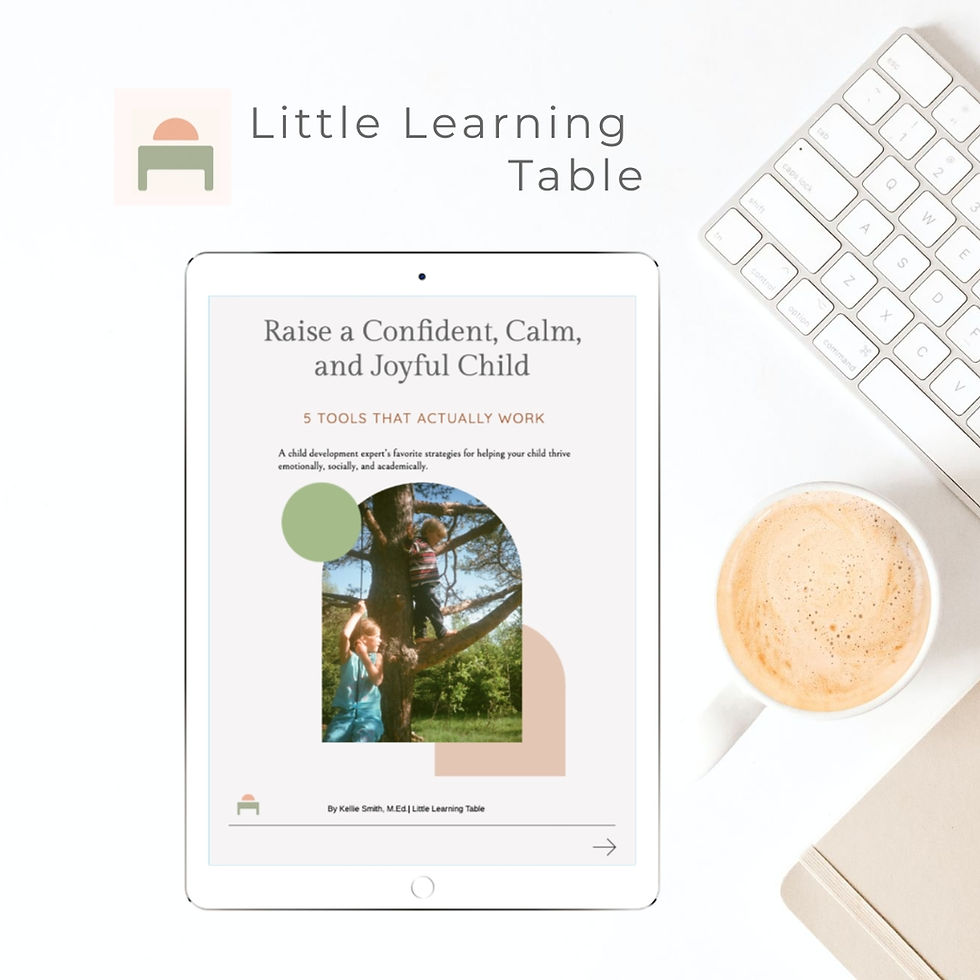Navigating Big Emotions: A Parent’s Guide
- Kellie Smith

- Jul 2
- 3 min read
Updated: Jul 24
By Kellie Smith, M.Ed.| Little Learning Table
As parents and caregivers, it’s common to witness intense moments when your child’s big feelings take center stage. These moments can include screaming fits, crying spells, or other emotional outbursts. It leaves you wondering what happened and how to respond effectively. Have you ever noticed patterns when these big emotions arise? Perhaps your child has a meltdown when they don’t get their preferred ice cream flavor, when bedtime approaches, or when it's time to clean up their toys. This behavior, often triggered by not getting their way, is typical in the home and can also appear in the classroom. Yet, the comfort of home may intensify these feelings even further.
Understanding the Root of Big Emotions
Big emotions in children usually stem from a sense of control. When things don’t go their way, children may feel frustrated or powerless. This is when self-regulation—your child’s ability to manage and control their emotions—becomes essential. By recognizing what triggers these strong feelings, also known as antecedents, you can start to plan ahead and mitigate these outbursts. But how can you help teach self-regulation skills from an early age?
Observing Patterns and Planning Ahead
The first step in managing emotional outbursts is to look for patterns. Are there consistent triggers for your child's big emotions? Does bedtime routinely lead to a meltdown during clean-up? Are transitions—like leaving a fun activity—especially difficult for them? Once you identify potential triggers, you can develop strategies to preemptively manage these situations.
Building Awareness of Triggers
Being aware of what sets off your child's emotions is crucial. Keep a journal to track their behaviors. Note when meltdowns occur and the context surrounding them. This awareness can provide insights into common triggers and help you devise effective coping strategies. For instance, if you notice that your child often struggles during transitions, it may be helpful to practice these transitions in a calm setting beforehand.
Strategies for Navigating Big Emotions
There are various strategies you can use to address your child's emotional outbursts effectively. Here are a few approaches to consider:
1. Setting a Timer for Transitions
A useful tool for managing transitions—like bedtime or clean-up time—is a visual timer. Let your child know how much time they have before it’s time to switch activities. For example, say, “You have ten more minutes to play, and then we’ll clean up and get ready for bed.” The timer offers a visual representation of the remaining time, helping your child feel more in control and reducing the chance of resistance.
2. Offering Choices to Foster Autonomy
Giving your child a sense of control can make a significant difference. Instead of merely instructing them on what to do, offer choices. For instance, “You can either clean up your toys first and then get ready for bed, or you can get ready for bed and then clean up your toys.” This small amount of autonomy can empower your child, reducing the likelihood of a meltdown.
3. Introducing a Token System
A token economy can help your child stay motivated to make positive choices. When they successfully navigate a challenge, such as cleaning up their toys without a meltdown, they earn a token. These tokens can be exchanged for a special reward, such as extra time with a favorite toy or a fun activity together. This approach helps build intrinsic motivation, encouraging your child to make positive choices because it feels rewarding, not merely to receive a new toy.
Avoiding the Pitfall of Extrinsic Motivation
While it may seem enticing to reward good behavior with tangible gifts, it’s important to avoid relying on extrinsic motivation (like buying new toys or treats). Instead, emphasize connection and meaningful rewards. A child motivated by intrinsic rewards—like enjoying quality time with you—is more likely to engage in positive behavior without expecting something in return.
Teaching Self-Regulation Through Patience
Teaching self-regulation is a gradual process. Some strategies may work briefly, but as your child grows and their emotions evolve, you may need to adjust your approach. Consistency, patience, and flexibility are crucial. Building these skills will take time, and you should recognize that each child learns differently.
You Are the Expert on Your Child
Remember, you are the expert on your child. By observing their behavior, identifying triggers, and experimenting with different strategies, you can empower them to navigate big emotions while developing lasting self-regulation skills. As your child becomes more adept at managing their feelings, you’ll lay the foundation for a calmer and more balanced approach to life’s challenges.
Conclusion
Navigating big emotions can be challenging, but you have the tools to help your child succeed. By encouraging self-regulation and acknowledging their feelings, you can foster resilience and emotional intelligence. Trust me, your child’s teachers will express their gratitude, too! 😊






Comments